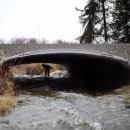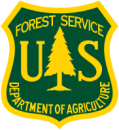States
OklahomaThis project will remove and replace four concrete low water fords on tributaries of the Glover and Mountain Fork rivers on the boundary of Ouachita National Forest in Oklahoma. A low water ford is a shallow area in a river or stream that allows vehicles to pass when water is low. Replacing these with new structures will increase the ability of aquatic organisms to migrate through the rivers and provide safer, more sustainable infrastructure for vehicles. Improved stream connectivity and habitat accessibility will benefit the Ouachita shiner and threatened leopard darter. These crossings are a high priority as this is the only watershed where leopard darter exists. This project will provide meaningful benefits to the surrounding community by improving the safety of the crossings and providing improved access to camping, fishing, and other recreational activities within the national forest.
Project Quick Facts:
| Project Status | In Development |
| Location | OK, McCurtain County |
| NFPP Project Funding | $1,000,000 |
| Restoration Techniques | Low water ford replacement |
| Accomplishments | 14 Stream Miles Reopened |
| Partner Project Lead | Ouachita National Forest |
The National Fish Passage Program combines technical expertise with a track record of success.
Implemented primarily through the Service's Fish and Wildlife Conservation Offices, the National Fish Passage Program provides financial and technical assistance to partners across the country. Since 1999, the program has worked with over 2,000 local communities, Tribes, and private landowners to remove or bypass over 3,400 barriers to fish passage fish passage
Fish passage is the ability of fish or other aquatic species to move freely throughout their life to find food, reproduce, and complete their natural migration cycles. Millions of barriers to fish passage across the country are fragmenting habitat and leading to species declines. The U.S. Fish and Wildlife Service's National Fish Passage Program is working to reconnect watersheds to benefit both wildlife and people.
Learn more about fish passage and reopen access to over 61,000 miles of upstream habitat for fish and other animals. Staff have expertise in fish migration and biology as well as financial, engineering, and planning assistance to communities, Tribes, and landowners to help them remove barriers and restore rivers for the benefit both fish and people.
Fish passage project proposals can be initiated by any individual, organization, government, or agency. However, proposals must be submitted and completed in cooperation with a Fish and Wildlife Conservation Office. (Please note that fish passage projects being used for federal or state compensatory mitigation or required by existing federal or state regulatory programs are not eligible for funding through the National Fish Passage Program.)
CONTACT A FISH PASSAGE COORDINATOR IN YOUR AREA TO GET STARTED.


